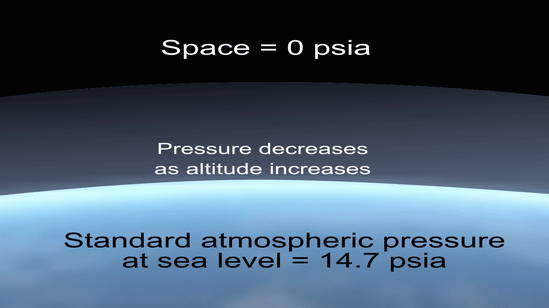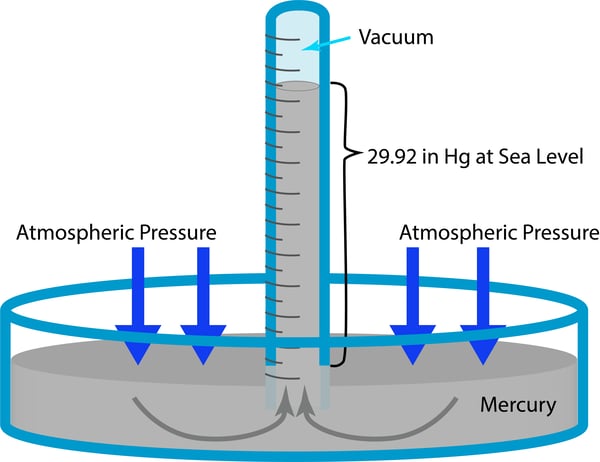A barometer is a pressure measurement device designed to measure atmospheric pressure, which is an absolute pressure caused by the weight and energy of the air captured in the Earth’s gravity. It is at its highest magnitude at the Earth’s surface and decreases as altitude increases until it reaches zero at the outer edge of the atmosphere, aka outer space.

Atmospheric pressure fluctuates on any given day depending on weather systems. High pressure systems are generally associated with clear, sunny skies, and low pressure with rainy, stormy weather. For this reason, barometers are instrumental in weather forecasting. By observing the barometric pressure across a weather system, forecasters can determine the movement and severity of the system.
Barometers can be made using a wide variety of technologies, but many are archaic and obsolete. This blog will concentrate on the most common barometer technologies in use today.
Mercury Barometer
A mercury barometer, also called a manometer, is a glass tube filled with mercury that is closed on one end and opened on the other. The open end of the tube is temporarily sealed so the mercury doesn’t flow out, then it is submerged below the surface of an open-to-atmosphere mercury reservoir or cistern. The seal on the open end is removed, which causes a portion of the mercury to flow out of the tube forming a near-vacuum at the closed end of the tube. It is a near-vacuum because of the mercury vapor present in that portion of the tube.
The remaining mercury in the tube represents the balance between the atmospheric pressure pushing on the surface of the mercury in the cistern, the weight of the mercury, and the vacuum in the tube. The resulting mercury level is a measurement of the force per unit area, or pressure, the atmosphere is exerting on the surface of the mercury relative to the vacuum (~zero force per unit area) in the tube. This is the absolute atmospheric pressure measured in units corresponding to the height of mercury above the surface of the mercury in the cistern.

A common pressure unit for barometric pressure is millimeters of mercury (mmHg) or inches of mercury (inHg). Mercury manometers were one of the first barometers to be used and were instrumental in the discovery of principles governing the atmosphere. The accuracy of mercury barometers depends on the accuracy of the height measurement, density and vapor pressure of the mercury used. Mercury barometers are impractical for many industrial applications and their use has diminished over time due to their size, cost, delicate nature, and toxicity of mercury. However, there are very expensive mercury manometers used in calibration labs today that serve as the lab’s primary source of pressure measurement (their primary reference standard).
Aneroid Barometer
An aneroid barometer is made without the use of mercury or any other fluid. It consists of a small, flexible metal chamber called an aneroid capsule, made of a beryllium/copper alloy. The chamber is sealed with most of the air pumped out of it. The difference in pressure between the inside of the chamber (a near-vacuum) and the outside causes it to expand or contract, depending on the change in atmospheric pressure. Mechanical linkages transfer this movement to a calibrated dial that shows the atmospheric pressure.
Aneroid barometers range in price and accuracy based on the manufacturer and quality. Price can range from $1000+ for an aneroid barometer with an accuracy as high as 0.07% of reading, to less than $50 for a barometer that may not even report the accuracy. Aneroid barometers are typically used aboard ships and sailing vessels for the purpose of monitoring the weather, in homes for the same purpose, or as a novel decoration.
Digital MEMs Barometer
A digital barometer uses a micro-electromechanical (MEMs) sensor to measure pressure. Pressure sensing MEMs are typically tiny integrated circuits (IC), which combine electronic and mechanical elements to sense pressure. The most common MEMs pressure sensors are either capacitive or piezoresistive.
Capacitive sensors sandwich conducting layers between a diaphragm to form a capacitor. Deformation of the diaphragm due to an applied pressure changes the capacitance, which is proportional to the pressure.
The piezoresistive sensor, on the other hand, has a conductive element fabricated directly on the diaphragm. Changes in the resistance of these conductors are proportional to the deformation of the diaphragm. This resistance is then measured through a Wheatstone bridge circuit to get a resistance measurement proportional to the pressure applied.
Both technologies are used in a variety of components including smart devices, weather stations, airplanes, drones, GPS instruments, environmental monitoring, medical devices, and more. Most of these devices use the barometric reading to determine changes in pressure due to altitude or weather conditions. They also measure environmental conditions inside buildings or medical devices. These sensors are used in almost every industry such as from automotive, aerospace, industrial, medical to consumer electronics. MEMs barometers can range in accuracy between 1% to 5% of reading. The cost of the individual sensor can be as low as $4, but they are usually packaged in much more expensive items like cell phones, HVAC monitoring devices or medical equipment.
Precision Digital Barometer
Aneroid and MEMS barometers must be calibrated in order to ensure their readings are accurate for their individual use. Precision digital barometers can serve this purpose. These barometers also contain MEMS sensors but have been characterized and calibrated to achieve much a higher accuracy compared to the devices they are intended to calibrate. The accuracy of these barometers can be as high as 0.008% of reading. Typically, a precision digital barometer used in calibrating other, lower accuracy barometers should be at least four times more accurate than the device being tested in order to maintain a 4:1 TUR (total uncertainty ratio).
Barometers in this class may also be used in any applications where high accuracy is required. These might include meteorological weather stations, airports, laboratories, critical production areas, hospitals, clean rooms, control rooms, and any application where high accuracy barometric pressure measurement is needed. Barometers in this class typically cost much more than an aneroid or MEMS Barometer, depending on capabilities and accuracy.
Conclusion
Barometers measure atmospheric pressure, but the type, accuracy, cost, and suitability for a specific application can vary widely. When looking for a specific kind of barometer, it is wise to use qualifying words in your search. When looking for a precision barometer, terms like high accuracy and precision, a specific accuracy requirement, or a specific application will inform your search and produce more appropriate results.
Related Reading:




